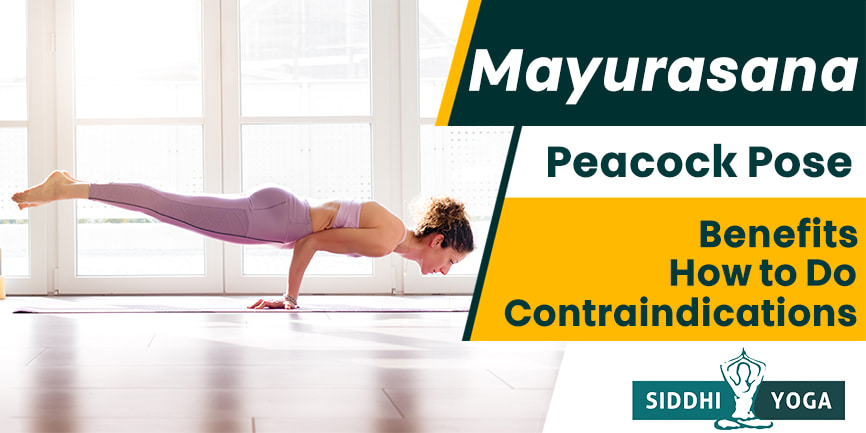
asana: “pose”
Mayurasana at a Glance
Mayurasana is one of the oldest not seated and hand-balancing asanas in Hatha yoga. It needs a great amount of mental and physical power and willpower to balance your whole body on your arms. In the final position pose, it looks as if the peacock walking with the feathers down so called Mayurasana.
Benefits:
- It helps to tone and improve digestive function.
- It helps to regulate the blood glucose level in your blood.
- It strengthens your reproductive system.
- This pose improves your body
- It strengthens your overall muscles and bones.
Who can do it?
This is an advanced level and requires, a great level of physical and mental strength. It has many benefits but not all can do it. People with intermediate yoga levels and advanced-level practitioners can do this asana. People looking to improve their core strength should do this asana.
Who should not do it?
This asana should be done with great care. People with severe injuries should avoid it. People with abdominal surgery should avoid doing it. Any heart concerns or high blood pressure should be avoided. Pregnant women should avoid it.
How to Do Mayurasana?
Follow the Step-by-Step Instructions
This is an advanced-level pose and not easy to do without good flexibility, balance, and core strength.
- Before doing this asana, you should prepare your body with some warm-ups, stretches, and preparatory poses, which are mandatory to avoid strain.
- Start in the Vajrasana, extend your back and arms on your thigh, and breathe gently to ease yourself.
- Now spread your knees and keep enough space between the knees.
- Now place your hands (palms flat) on the floor and here the fingers should point to your knees.
- Slowly bend your elbows and bring them near your abdomen (your navel region).
- Now tighten your core and bring your head down towards the floor slowly.
- Here, your hip and knees should be in one line, and the upper feet should be on the mat.
- Now, slowly straighten your legs back and balance your body on the toes and palms.
- Now, you must engage your core, press your elbows against it, and slowly lean slightly forward to lift your legs.
- Slowly lift your legs, engaging the core and balancing on the arms, lift your head a bit, and gaze directly forward.
- This is the final position of the Mayurasana pose. Balance here as long as you can.
- When you release, bring your legs down and then your knees to the floor, and come back to the Vajrasana by bringing your upper body straight.
- Rest in the Shavasana to cool down.
What are the Benefits of the Mayurasana?
- It helps to detoxify your body by removing the toxins.
- It strengthens the abdomen and helps to improve your digestion (digestive fire).
- It also helps to strengthen the reproductive system.
- It helps to strengthen the muscle strength of the elbow, spine, wrist, and shoulders.
- This asana improves your focus and concentration and helps to coordinate between your mind and body.
Health Conditions that Might Benefit from Mayurasana
- This detoxifies your body and keeps you away from many diseases.
- This improves digestion and can also avoid other diseases in your stomach.
- This is good for your kidney and liver due to increased pressure while in the pose.
- This stimulates the vagus nerve, helps to release tension, and calms the brain.
- This helps to stimulate the cells in the pancreas to produce insulin and so can be helpful to diabetic people.
Safety and Precautions
- You should perform Mayurasana on an empty stomach.
- if you have any injury in your wrist, shoulder, or elbow, avoid doing it.
- High BP, people should not do it.
- Don’t practice during your menstrual cycle.
- If you find any pain or discomfort in the pose, just come out of it.
- People with migraines should avoid doing it.
Common Mistakes
- Misalignment of your hand placement.
- Avoiding warmups and preparatory yoga poses for the peacock pose can lead to great injury.
- Your back should be straight.
- Don’t drop your head down.
- Being an advanced pose, progress gradually, and with regular practice you can get into the final peacock pose.
- Don’t force yourself into the pose.
Tips for Mayurasana
- Do it on a yoga mat for better grip.
- Warm-up is very important.
- Keep your core activated to shift the weight to the lower body.
- Avoid rounding your back while in the pose.
- Look forward to maintaining the balance.
- Use yoga props for support and comfort.
- Bring your body weight forward and lift up your legs from the floor.
- Keep breathing gently.
- Your fingers point towards your body.
- Respect and listen to your body.
- For proper guidance practice under a trainer yoga trainer.
Physical Alignment Principles for the Mayurasana
- Hands should be placed firmly on the ground.
- The fingers pointing toward the knees.
- Elbows should be aligned beside the navel region and close to each other.
- Keep your shoulders strong and balanced.
- Your torso should rest on the back of your upper arms and slightly lean forward.
- Keep your core and upper body engaged throughout the pose.
- Shift your weight forward onto your hands by pushing gently and slowly with the balls of your feet and your toes.
- Your lower back, buttocks, and thighs should be engaged.
- Leggs engaged and straight and extended.
- The feet should be flexed.
- Keep your head straight and look forward and don’t round your back.
- Keep breathing throughout the pose.
Mayurasana and Breath
Take focused, deep, and even breaths. Before you start the Mayurasana yoga practice, breathe gently to ease yourself. When you are about to lift your body, inhale deeply and exhale as you lift your body off the ground. When you hold the pose, let your breath flow gently to maintain balance and stability with the engagement of the core.
Mayurasana and Variations
- Modify keeping a yoga block under your pelvis to balance your body.
- You can also do a half peacock pose with one leg (left leg or right leg)
- The advanced variation is Padma (lotus pose) Mayurasana.
- You can also do the Swan pose.
Take Away
Mayurasana is a great pose to improve digestion, reduce stress levels, tone abdominal muscles and improve balance. It also has many other benefits such as strengthening the shoulders, back, and legs. It is an excellent Yoga pose for controlling blood sugar levels in diabetics. However, it is not recommended during pregnancy or menstruation.
Are you passionate about yoga and dream of teaching others? Our comprehensive yoga teacher training courses have got you covered! Explore the 200-Hrs Yoga Teacher Training Course, delve deeper into your practice with the 300-Hrs Yoga Teacher Training Course, or master the art of teaching with the 500-Hrs Yoga Teacher Training Course – all certified by Yoga Alliance. Your journey towards becoming a certified yoga instructor begins here. Join us today and let your yoga journey blossom!

Responses